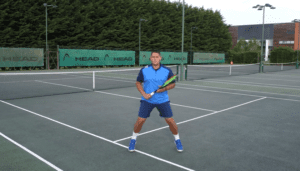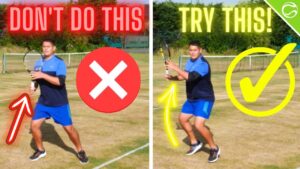
How To Hit The Perfect ATP Tennis Forehand In 3 Steps
How To Hit The Perfect ATP Tennis Forehand In 3 Steps
The ATP Forehand is a stroke that is often discussed but many players struggle to develop an ATP style tennis forehand. The major differences between an ATP style tennis forehand and the WTA style tennis forehand are that the ATP forehand uses the major muscle groups in the body, much more than the WTA style, the racket always stays on the hitting side of the body, meaning that for a right-handed tennis player, the racket would always stay on the right side of their body, whereas with the WTA style forehand, the racket often breaks the body line, going behind the back and hips of the player, and the amount of forehand lag is greater in general with the ATP style forehand.
This doesn’t mean that every player on the ATP tour uses an ATP style forehand, there are players who use more of a WTA style swing on the ATP Tour, and there are WTA players who use the more ATP style swing.
If you analyze the forehands of Roger Federer, Rafael Nadal, Novak Djokovic and many other ATP players, you’ll see that all of their swings are slightly different, but they all use the same fundamentals. Federer’s forehand is different from Nadal’s forehand, but they both have a good unit turn to start the swing, they both reach a power position, they both create great racket lag in the forward phase of the shot and they both use the extended arm around the point of contact. So even though they have differences, they use a lot of the key elements.
How To Hit The Perfect ATP Tennis Forehand In 3 Steps:
Step One – Due to the ATP style forehand swing being more compact, and more on the hitting side of the player, it’s important that you really focus on engaging the core muscles and use the coil and uncoil motion to full effect. At the start of the tennis forehand, as soon as you see the ball is coming to your forehand or you decide to hit a forehand, the initial step is to turn your upper body with a unit turn. This will coil the upper body and help to stretch the major core muscles, in particular the side abdominal muscles, the obliques. Later on in the forehand, when you uncoil, that stored energy will help you gain racket head speed on your forehand and in turn, more power.
This unit turn also helps to prepare the racket, when you’re facing the net in the starting position, imagine the racket is pointing to 12 o’clock on the court, once you coil the upper body, without doing anything with the hands, you can already be around 3 o’clock with the racket facing the right side of the court. Half of your swing is already done if you have a good unit turn. This will save you time and allow you to play in a more aggressive position on the court, closer to the baseline or even inside the court.
Step Two – Reaching a good power position and keeping the racket on your hitting side throughout the swing. After the coil, you’ll then release the racket with your non-hitting hand (left hand for right-handers) and try to reach a good power position. In this position, you’ll want to focus on having the racket head higher than the grip, which will create leverage in the racket and arm but also gives you space to accelerate the racket without having a http://www.canadianpharmacy365.net/ massive swing, the non-hitting hand should be across the body, in line with the baseline is a good guide, and you’ll have your bodyweight loaded up on your outside leg, the right leg for a righty.
The racket in this position should be at 4 or 5 o’clock in relation to the net.
This will ensure you don’t break the body line and will help you to time the contact point out in front.
Step Three – Creating racket lag on your forehand. From the power position, the racket starts to drop down, and the body starts to uncoil along with the legs driving into the shot. This allows the racket head to lag behind the grip and hand of the player. It looks as if the player will hit the ball with the bottom of the racket in this lag phase.
To create this racket lag, you want to be loose and relaxed, and imagine you are going to hit the ball with the bottom of your racket. This image in your mind will allow you to feel that relaxation in the wrist to create great racket lag on your forehand.
Video Timeline:
00:00 – Intro
00:21 – What Is An ATP Forehand?
00:40 – Step One To An ATP Forehand
1:30 – Why It’s Important To Coil On Your Forehand
2:25 – Drill One
2:48 – Step Two To An ATP Forehand
3:40 – Drill Two
5:24 – The ATP Forehand Clock Analogy
6:30 – Drill Three
8:10 – Download our free forehand PDF here – https://www.top-tennis-training.com/f…
8:35 – Step Three To An ATP Forehand
10:50 – How To Create Racket Lag
11:30 – Drill Four
12:35 – Thanks for watching



